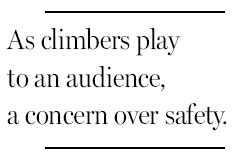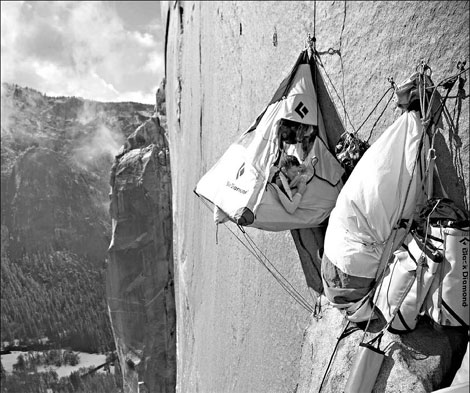Online, on a ledge: a solitary sport is turning social
Updated: 2012-02-12 07:52
By Alex Lowther(The New York Times)
|
|||||||
|
While climbing in California, Tommy Caldwell posted on Facebook, which some say compromises the sport. Brett Lowell / Big Up Productions |
Last November the climber Tommy Caldwell lived on a portable ledge hung 365 meters up on the sheer face of El Capitan, the massive sweep of granite that stands sentinel over Yosemite Valley in eastern California, for more than two weeks.
One of the world's best rock climbers, Mr. Caldwell slept on the ledge - which is actually a hanging nylon tent - cooked on it and went to the bathroom in a receptacle hanging below it. And at the top of this solitary, silent sport, he was being watched by thousands around the world. From Singapore: "Inspirational, Tommy! Well done!" From Poland: "Smiles from Krakow. Keep pressing!!!"
Mr. Caldwell, 33, updated his progress on Facebook using his iPhone, which he charged with portable solar panels. His fans, a group that grew to more than 4,000 during his climb, could follow along in real time with commentary from the climber himself. No need to wait days, weeks or months for a print article or video.
The Dawn Wall, as Mr. Caldwell's project is known, is the latest example of what has become an increasingly accepted practice in the climbing community: from-the-route social media. Observers enjoy it, sponsors encourage it and climbers get to share what is inherently a solitary pursuit.
But a vocal minority questions what happens to a sport whose ideals of purity are traditionally based on adventure, commitment, self-sufficiency and individual achievement when online interaction happens instantly. Katie Ives, the editor of Alpinist magazine, worries that "instead of actually having the experience be the important part, it's the representation of the experience that becomes the important part - something is lost."
David Roberts, a writer and climber, said from-the-route media "introduces a fatal self-consciousness" to a climb. It removes the "blissful sense of being alone out there."
On his recent climb on El Capitan, Mr. Caldwell battled fatigue and the impending winter on what will be considered the hardest big wall free climb in the world (free as in free of aid; he used a rope and protection in case of falls, but only his hands and feet to go up). Mr. Caldwell said the climb felt different from others. "It felt like there were a lot of people watching our progress, like a football game," he said. "Usually when I climb it's just me and my partner. It's a very solitary thing."
By the late 1990s, satellite linkups and the Internet had reduced the interval between an event and coverage of it to virtually nothing. In 1999, on an expedition that made the first ascent of the northwest face of Pakistan's Great Trango Tower, an unseen line was crossed. A highly visible, remote objective matched with a reported sponsorship budget of $50,000, a full camera crew and daily Web updates from the climbers drew the ire of the wider climbing community.

Mark Synnott, one of three climbers on the expedition, said he came away from the experience conflicted. "It was a necessary evil," he said of all the media. Without the computers and cameras there would not have been an expedition, and without the expedition there would have been no new cutting edge route on the tower.
"The idea is pretty cool if it can be done the right way," Synnott said.
Caldwell, the El Capitan climber, said people perceived the Great Trango Tower expedition as "bringing something into the mountains that didn't belong there." But something has changed, he said. "People started to realize it could add to the experience."
In 2008, nine years after the Great Trango Tower expedition, a young climber and artist named Renan Ozturk traded his sketchbook and pencils for a few new tools that would allow him to film, edit and upload media from the base of a remote wall in the Indian Himalayas.
Ozturk, a sponsored athlete who was part of the climbing team, said his idea was to make media that was "authentic in a good way." He added, "If the people are doing it for the right reasons, it will show."
But Zack Smith, a world-class alpinist, said he had rejected the trappings of professional climbing, sponsorship and documentation of his climbs.
"I want to make decisions from my heart, my gut, my brain," he said. He invoked Kodak courage, the idea that people tend to push harder when being filmed or photographed.
"Climbing mountains is a dangerous pursuit," he said.
"When you mix in the potential desire to impress people, that's a very dangerous thing."
Before an injury forced him off the wall, Kevin Jorgeson, 27, was Mr. Caldwell's partner on the route. He began posting updates via Twitter in 2010. Last year, facing a large snowstorm, Mr. Caldwell and Mr. Jorgeson posed a question on a message board, to see if their hanging camp might be susceptible to falling ice after the storm cleared. People with experience on the wall responded that their camp was unprotected and would be showered with dangerous chunks of ice.
The climbers retreated the next day.
The New York Times
(China Daily 02/12/2012 page12)
